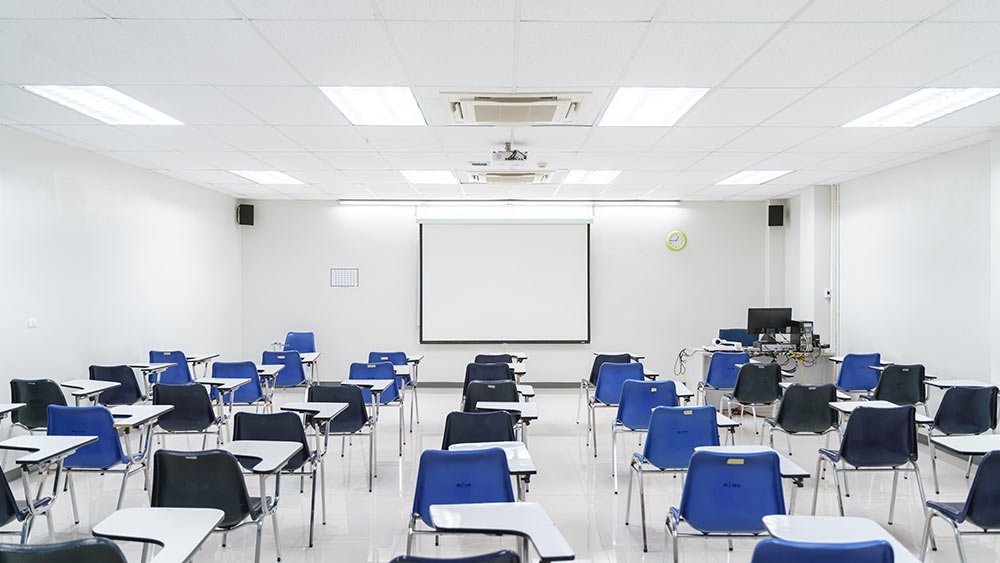
Key Takeaway
- Air conditioning in schools ensures cool classrooms, helping students focus and learn without heat disruptions.
- Air conditioning systems for schools like mini-splits and window units provide efficient cooling without requiring lengthy ductwork.
- Smart thermostats and smart AC controllers help optimize classroom climate and cut energy costs.
Trying to solve an advanced math problem or learning what happens when different chemicals react is hard enough already. On top of that, if students have to deal with the summer heat, it can become next to impossible to concentrate in the classroom.
Extreme summer heat can make students feel tired and sluggish, impacting their productivity and reducing focus time. In addition, high temperature combined with humidity can trigger allergy symptoms or aggravate other health-related issues.
Air conditioning in schools can be a great way to deal with high temperatures and humidity. A good indoor climate will not only make students comfortable in the classroom but also lead to improved concentration and learning outcomes.
Why Do Schools Need Air Conditioners?
Schools require air conditioners because, in summers, classrooms can get unbearably hot. In this case, instead of focusing on learning, the brain would rather focus on keeping the body cool. As a result, students won’t be able to perform their best academically.
1. Improved Focus & Concentration
When the weather is too hot, it’s difficult for students to focus on their work in schools without air conditioning. Research conducted by Harvard shows that students have a hard time learning new concepts when the temperature is at extreme levels. Moreover, they also tend to get low grades on tests taken on hot days. They are 12 percent more likely to fail the test if they took it on a 90-degree day as compared to a 72-degree day.
Teachers also complain that the lack of air conditioning in schools makes it really tough to engage students. They also have to deal with more disciplinary issues with the rising temperatures.
With air conditioning, indoor temperature can be regulated, and students will be able to concentrate better.
2. Reduced Asthma & Allergy Symptoms
In summer, high humidity levels can be a big source of discomfort. Students with asthma or allergies suffer more as mold, bacteria, and dust mites thrive in humid environments. These harmful indoor air pollutants result in various health issues for students, forcing them to miss school days.
Since air conditioners also dehumidify the indoor air as part of their cooling process, it can help maintain humidity levels. In addition, AC filters remove most of the contaminants and help improve indoor air quality.
3. Reduced Downtime
In the summer months, schools often have to close down due to the extreme temperatures. While it’s necessary to close the schools in this situation, this disrupts the learning process. With air conditioning, schools can stay open even when it’s hot outside without compromising on students’ comfort.
Which Type of Air Conditioner Is Best Suited for Schools?
From mini-splits to window units, let’s take a look at different types of air conditioners for a classroom.
Wall-Mounted Mini-Splits

Wall-mounted mini-splits are highly efficient air conditioning systems. They consist of one or more units connected to an outdoor compressor.
Mini-split installation takes less time and is quite easy as compared to a traditional ducted HVAC system. Since there are no ducts involved, cooled air is pushed directly to the room where the indoor unit is installed, eliminating the risk of air loss.
In classrooms, the indoor air handler should be installed where they can provide maximum and even airflow. Two units can be installed in large rooms instead of one large unit for balanced air circulation and to avoid any hot and cold spots. You can look at this handy guide on air conditioner sizing for a better understanding.
Ductless mini-split heat pumps can not only cool the classes but also provide supplemental heating in winter, which makes them a flexible air conditioning option for schools.
When it comes to improving indoor air quality, mini-splits filter out airborne allergens and deliver clean air to the intended area. This will help to reduce allergy symptoms in students and prevent fatigue and nausea due to poor air quality.
Cassette Air Conditioners for Classrooms

A cassette air conditioner is a type of mini-split recessed into the ceiling. Just like any other split unit, it also has an indoor unit to deliver cool air and an outdoor unit to remove the collected heat outside.
The indoor unit is centrally placed in the ceiling dispersing conditioned air in four directions which can help provide an even airflow across the room. This makes cassette air conditioners are ideal for large classrooms or school halls.
Under Ceiling Air Conditioners

Under ceiling unit, as the name suggests, is mounted underneath a ceiling with the help of fasteners, providing cool air without occupying any valuable space. Unlike ceiling cassette ACs, which are placed within a ceiling, these are mounted near a wall and just below the ceiling.
They are powerful, yet cost-effective units and are mostly used in offices and school buildings where floor or wall space is at a premium. They provide high airflow up to a considerable distance, which helps reduce the number of units required in a classroom. This also reduces the cost of installing multiple units.
Window Air Conditioners for Schools
Window air conditioners are a popular choice for schools, as they are relatively affordable. Besides, window air conditioners are the easiest to install.
As they don’t take up floor space, window units are perfect for smaller classrooms. However, window air conditioners can cool a single space at a time, so different units would be required in each class.
Window air conditioners come with various features, including timers and temperature controls, making them a great option to regulate the climate in a classroom.
Central Air Conditioning for Schools
A central air conditioning unit uses ducts and vents to deliver conditioned air. It consists of an air handler, a compressor, and a series of ducts.
If a school already has ductwork installed, it makes perfect sense to use a central air conditioner to cool the classroom in summer. It is still possible to add a central system to a school without previously existing ducts. However, that would require extensive renovation, which can be costly. To save on the renovation costs, they are often installed in new school buildings.
Central air conditioners are designed to cool a whole building instead of individual rooms. This can lead to cooling in unoccupied areas, affecting AC efficiency and energy bills. A simple solution is to install HVAC dampers and create a zoning system. It ensures that cooling is directed only towards the classrooms where it’s needed.
Smart Air Conditioning for Schools
In schools, the best option is to connect the air conditioning systems with smart thermostats or smart AC controllers. Smart thermostats work with central systems while smart AC controllers can be paired with mini-split, portable, and window ACs. These smart devices can then be used to automate the classroom climate.
Your best choice to make any mini-split, window,
or portable AC smart. Enhance your comfort and savings.

These climate control devices offer control beyond basic temperature control. Using smart controllers, air conditioners in schools can be scheduled to turn on/off at specific timings. In addition, the school administration can use them to keep track of AC filter cleanliness levels to prevent allergy issues in students. Moreover, these smart climate control devices can help save on bills by monitoring AC usage.
Cielo Breez smart AC controllers have a unique feature called Comfy Mode that allows you to set intelligent triggers. For example, if the classroom temperature/humidity exceeds or falls below a pre-set value, this mode automatically turns your AC on/off. This will help teachers and students focus on their work instead of constantly worrying about the temperature changes.
The Takeaway
Air conditioners keep classrooms at a comfortable temperature, which helps improve focus and productivity. Additionally, having an AC unit can help protect students from seasonal allergies and improve indoor air quality. Mini-split, window, and central units are some of the best air conditioners for schools. These units are highly efficient and will help keep students cool and focused in the classroom.








